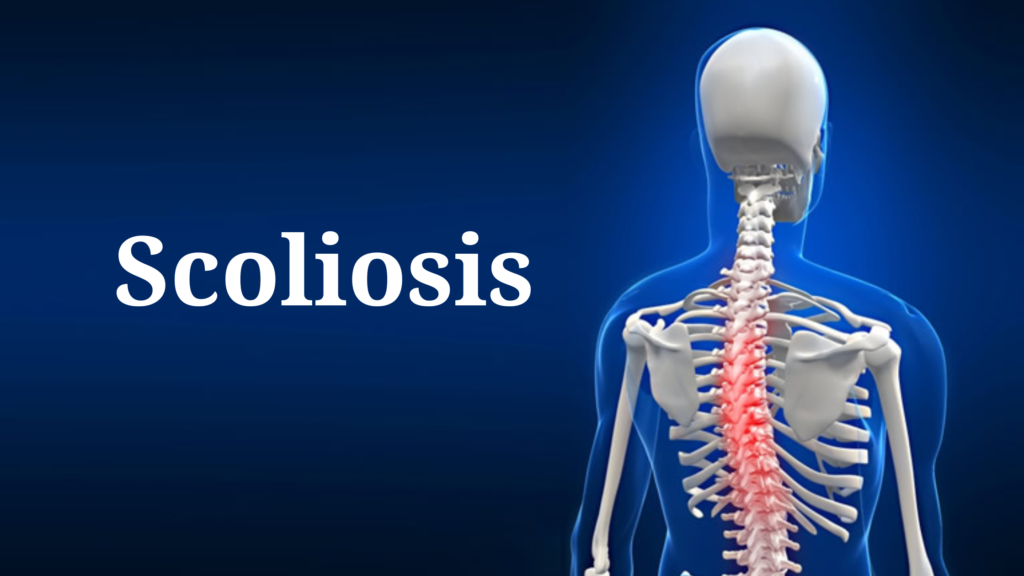Scoliosis is a condition where the spine curves abnormally to the side, forming an “S” or “C” shape instead of the natural straight alignment. The curve can be mild or severe, and it may cause problems with posture, pain, and, in extreme cases, even affect the lungs and heart.
🦴 What is Scoliosis?
- Scoliosis is an abnormal curvature of the spine, usually occurring in the thoracic (upper back) or lumbar (lower back) regions: 🦵➡️
- The spine is supposed to be straight, but in scoliosis, it may curve to the right or left: ⬅️➡️
⚠️ Types of Scoliosis:
There are different types of scoliosis based on its cause:
- Idiopathic scoliosis: The most common form, with no known cause. It usually develops in adolescence (often during growth spurts). It can also be genetic: 🧬👧
- Congenital scoliosis: Caused by abnormal development of the spine in the womb: 👶🦴
- Neuromuscular scoliosis: Associated with neurological or muscular conditions, such as cerebral palsy or muscular dystrophy: 🧠💪
- Degenerative scoliosis: Occurs in older adults due to spinal degeneration (often associated with aging, arthritis, or disc degeneration): 🦵👴
🧑⚕️ Symptoms:
The symptoms of scoliosis can vary depending on the severity of the curve:
- Uneven shoulders: One shoulder may appear higher than the other: 💪📈
- Uneven hips: One hip might stick out more than the other: 🦵🦴
- Back pain: Particularly in adults, scoliosis can cause back or neck pain due to muscle strain: 🤕🦵
- Lean to one side: The person may appear to lean to one side due to spinal curvature: ↩️↪️
- Breathing problems: In severe cases, the curve can press on the lungs, causing difficulty breathing: 🌬️💨
- Fatigue: Due to the strain on the muscles from trying to compensate for the spinal curve: 😓💤
⚙️ Diagnosis:
- Physical exam: A doctor will look for visible signs of scoliosis, such as uneven shoulders or hips: 🩺👀
- X-rays: The primary test to measure the degree of the curve (in degrees), known as the Cobb angle: 📸🦴
- MRI or CT scan: Sometimes used if there are concerns about nerve involvement or underlying causes: 🧠📊
📏 Severity and Curve Measurement:
- Scoliosis is measured based on the degree of curvature:
- Mild scoliosis: Curves between 10°-25°: 🌱
- Moderate scoliosis: Curves between 25°-40°: ⚖️
- Severe scoliosis: Curves greater than 40°– 50°: ❗🔴
- Severe curves (greater than 70°) can lead to respiratory and cardiac problems: 💨💔
💊 Treatment:
Treatment for scoliosis depends on the age of the patient, the severity of the curve, and whether it’s progressing.
- Observation: For mild cases, doctors may just monitor the curve over time with regular X-rays: 📸🔄
- Bracing: If the curve is moderate and the patient is still growing, a brace can help prevent further curvature: 🦴🦺
- Physical therapy: Exercises to strengthen muscles, improve posture, and alleviate pain: 🧘♀️🏋️♀️
- Medications: Pain relievers to manage discomfort: 💊💥
- Surgery: For severe scoliosis (or if the curve is progressing rapidly), surgery may be necessary. The most common procedure is spinal fusion, where the vertebrae are fused together to stop further movement: 🔨🦴
🏥 Spinal Fusion Surgery:
- In spinal fusion, rods, screws, or plates are used to hold the spine in a straighter position. This procedure helps stop further progression of the curve: ⚙️🦴
- Recovery can take time, and physical therapy is often required to regain full mobility and strength: 💪⏳
🌱 Prognosis:
- Mild scoliosis may not require treatment and may not significantly affect daily life.
- Moderate to severe scoliosis may need treatment to prevent further progression and to manage symptoms like pain or respiratory issues.
- With early detection, the prognosis can be very good, and many people with scoliosis live normal lives: 👩⚕️💪
🔄 Preventing Scoliosis:
While idiopathic scoliosis can’t be prevented, here are a few things that might help minimize the progression:
- Regular check-ups: Monitoring during childhood and adolescence can catch scoliosis early, before it progresses.
- Exercise: Maintaining strong core muscles can help manage back health, even if scoliosis is present: 🏋️♀️🤸♀️
- Posture: Good posture can prevent unnecessary strain on the spine: 🧘♀️🔄
